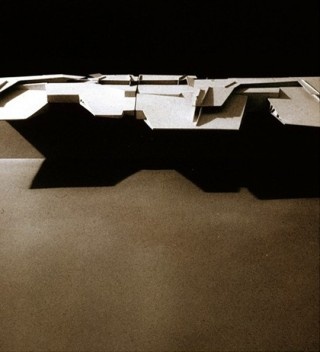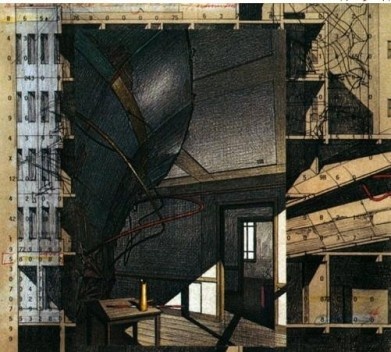
Model of the six-kilometer long terrace, cantilevered over the sea, able to rotate under flood pressure to become a vertical barrier protecting the city of La Habana (Model by Lebbeus Woods in collaboration with Ekkerard Refeldt) [lebbeuswoods.net]
The black sheep, the black swan and the experimental architect.
It was – at least we like to imagine it this way – a bright and sunny day of Summer 1988 when a bunch of irregular architects met at Emmond Farms, to take part in the First Conference of the newly found Research Institute for Experimental Architecture, under the guidance of Lebbeus Woods. Almost 25 years later architects committed to experimentation are still considered the black sheep in the architecture hoard, often exiled at the outer borders of the discipline by the widespread doubt that there is little need for experimental architecture.
Yet, when we look at the tragic sequence depicting the mass-destructive power of the architecture-natural forces coupling device, the post-human landscape of a shrinking Detroit turned into a literally green city by abandon and decay, the reduction of architecture to mere styling for affluent clients in the world hundreds of Dubai-like speculations, whose volatile foundations lay more on virtual financial fluxes than solid ground, we can no longer escape the evidence of the fallacy and crisis of mainstream architectural paradigms.
The modernist positive legacy that still pervade the conceptual foundations of the discipline does not allow for a proper understanding of the role of indeterminacy, unpredictability and uncertainty in a world where the dance of the black swan can no longer be considered a misfortuned accident.
If architecture is the instrument we use to define the way we inhabit the world, than we still have a long way to go before we can call it home. This is why truly experimental architecture is much needed: to investigate ways in which architecture can anticipate or provoke changes, and to envision forms of space that question our very placement within the world.
Not unlikely the role of the experiment in sciences, the architectural experiment allows for investigation of problems and testing of new architectural hypothesis, through drawings and models that serves as the experimental laboratory.
We all know architecture is not a science, at least not a positive one, but the lifelong work and research of Lebbeus Woods stand as the brightest example that such a thing as the experimental architect exist. And, what is more important, we really need it.
The works and writings of Lebbeus Woods unveil a deep and hidden fracture that severs the intellectual and critical practice of architecture - often exercised by a handful of high-profile, and occasionally aloof, theorists - from its business-as-usual, labour-intensive counterpart - no matter how big the firm, or how glossy the cover of the magazine featuring its projects.
The Experimental Architect (1) inhabits the space that lies between these two extremes. And in this obscure grey area he or she, rather like Johnny Cash’s “A Boy Named Sue”, travels alone along unexplored paths and trajectories that bridge the two shores of failure: a “Stranger in a Strange Land”.
note
1
Check lebbeuswoods.wordpress.com/2010/08/12/the-experimental




